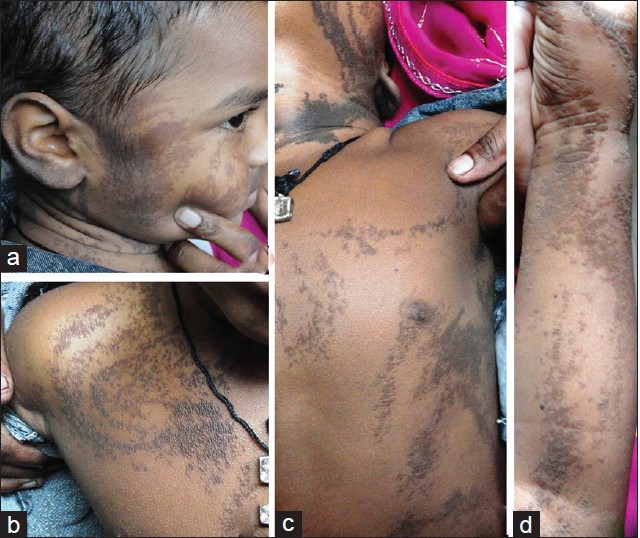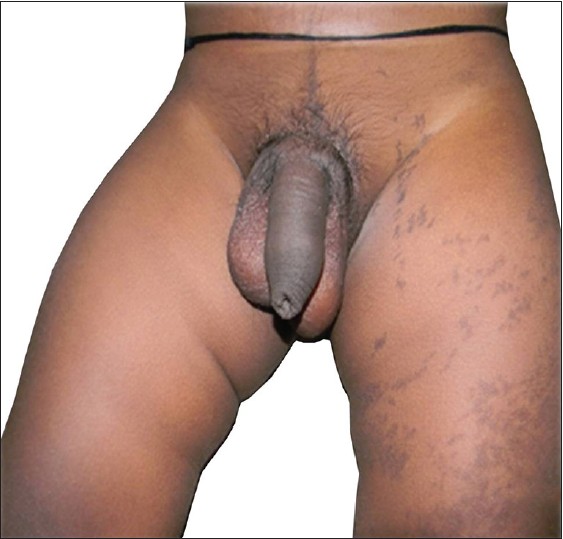Translate this page into:
Precocious puberty in a 3-year-old child with systematized verrucous epidermal nevus
Correspondence Address:
Taru Garg
Department of Dermatology and STD, Lady Hardinge Medical College and Associated Hospitals, New Delhi
India
| How to cite this article: Garg T, Chander R, Gaur N, Sahni K. Precocious puberty in a 3-year-old child with systematized verrucous epidermal nevus. Indian J Dermatol Venereol Leprol 2015;81:197-198 |
Sir,
Widespread epidermal nevi may be associated with extracutaneous findings. [1] We herein describe the association of precocious puberty with systematized verrucous epidermal nevus in a child.
A 3-year-old boy presented with hyperpigmented velvety skin lesions over the face, trunk and extremities since the age of 3 months. He was born after a prolonged and difficult delivery assisted by an untrained birth attendant. The child was diagnosed with cerebral palsy. At the age of 3 months, he had an episode of generalized tonic clonic seizures, which was successfully treated with sodium valproate. The child also had motor and speech developmental delay.
On examination, he was irritable. The child′s head circumference and weight were at the 50 th percentile for his age. His height was appropriate for the age of 3 years and 8 months. Cutaneous examination revealed multiple hyperpigmented velvety and slightly elevated plaques in a blaschkoid distribution over the left side of the forehead, cheeks, neck and trunk. The left upper limb and lower limb were also involved. There was a sharp midline demarcation, with slight extension onto the right side [Figure - 1]. He had a large penis and testicles with thick terminal hair in the pubic region [Figure - 2]. Central nervous system examination revealed increased tone and exaggerated deep tendon reflexes in both upper and lower limbs, with normal muscle power. Contractures were present at the knee and ankle joints due to spasticity. No abnormality was detected on ocular examination. His IQ assessment showed an IQ of 50, suggestive of mild mental retardation.
 |
| Figure 1: Multiple hyperpigmented velvety plaques in a blaschkoid distribution over (a) face, (b) right side of trunk, (c) neck and left side of trunk, (d) forearm and hand |
 |
| Figure 2: Large sized testes and penis with presence of thick terminal hair in the pubic region |
Skeletal survey was suggestive of advanced bone age (5-6 years). Magnetic resonance imaging of the brain revealed periventricular leukomalacia (ischemic brain injury). Ultrasound of abdomen was normal. Ultrasonography of the scrotum revealed the size of the right and left testes to be 2.7 × 1.4 and 2.9 × 1.5 cm respectively, which was larger than expected for a 3-year-old child. The hormonal profile showed luteinizing hormone (LH), follicle stimulating hormone (FSH) and testosterone levels to be in the pubertal range, while 17-hydroxy progesterone levels were normal. Histopathological examination of a skin lesion showed hyperkeratosis, acanthosis, papillomatosis and flattening of rete ridges.
On the basis of these findings, a diagnosis of systematized verrucous epidermal nevus with central precocious puberty and concomitant spastic cerebral palsy was made. The child was started on injectable leuprolide depot preparation 3.75 mg intramuscularly once every 4 weeks for precocious puberty. He was advised physiotherapy and oral baclofen 10 mg twice daily for treatment of spasticity. Topical tretinoin 0.025% was advised for the facial lesions with no response at 3 months of follow up. However, the spasticity reduced and there was no further progression of pubertal changes. The patient was lost to follow up subsequently.
Most reported abnormalities with epidermal nevi have been in the skeletal, neurologic, and ocular systems. [1] The association of precocious puberty with systematized verrucous epidermal nevus is uncommon. [2],[3],[4] Precocious puberty is generally due to early activation of the pulsatile activity of the gonadotropic axis. Pulsatile secretion of hypothalamic gonadotrophin releasing hormone (GnRH) leads to an increase in leutinizing hormone (LH), and to a lesser degree, follicle stimulating hormone (FSH) secretion, features of central precocious puberty. In the majority of cases, no cause of central precocious puberty is identified on MRI evaluation and they are labelled as ′idiopathic′. [5]
Sexual precocity in our patient may be due to premature maturation of the hypothalamic-pituitary axis (true/central precocious puberty) rather than end organ activity. This was evident in the hormonal profile of the patient, which revealed pubertal levels of LH and FSH. It has been hypothesized earlier that extensive epidermal nevi may release certain factors that can induce puberty. [6] It is also important to rule out hamartomas or tumors in the brain in such patients. There was no evidence of such brain growths in our patient. The patient had cerebral palsy, which may be a coincidental association considering the birth history.
We were able to find very few prior reports of precocious puberty occurring in association with verrucous epidermal nevus. [1],[2],[3],[4],[6] The disease course, management and long term prognosis of this association has not been described earlier. It is essential to be aware of this rare association in order to provide timely treatment for precocious puberty.
| 1. |
Rogers M, Mc Crossin I, Commens C. Epidermal nevi and the epidermal nevus syndrome: A review of 131 cases. J Am Acad Dermatol 1989;20:476-88.
[Google Scholar]
|
| 2. |
Tay YK, Weston WL, Ganong CA, Klingensmith GJ. Epidermal nevus syndrome: Association with central precocious puberty and woolly hair nevus. J Am Acad Dermatol 1996;35:839-42.
[Google Scholar]
|
| 3. |
Moss C, Parkin JM, Cornaish JS. Precocious puberty in a boy with a widespread linear epidermal nevus. Br J Dermatol 1991;125:178-82.
[Google Scholar]
|
| 4. |
Shahgholi E, Mollaian M, Haghshenas Z, Honarmand M. Congenital rhabdomyosarcoma, central precocious puberty, hemihypertrophy and hypophosphatemic rickets associated with epidermal nevus syndrome. J Pediatr Endocrinol Metab 2011;24:1063-6.
[Google Scholar]
|
| 5. |
Carel JC, Lahlou N, Roger M, Chaussain JL. Precocious puberty and statural growth. Hum Reprod Update 2004;10:135-47.
[Google Scholar]
|
| 6. |
Ivker R, Resnick SD, Skidmore RA. Hypophosphatemic vitamin D-resistant rickets, precocious puberty, and the epidermal nevus syndrome. Arch Dermatol 1997;133:1557-61.
[Google Scholar]
|
Fulltext Views
9,078
PDF downloads
1,959





